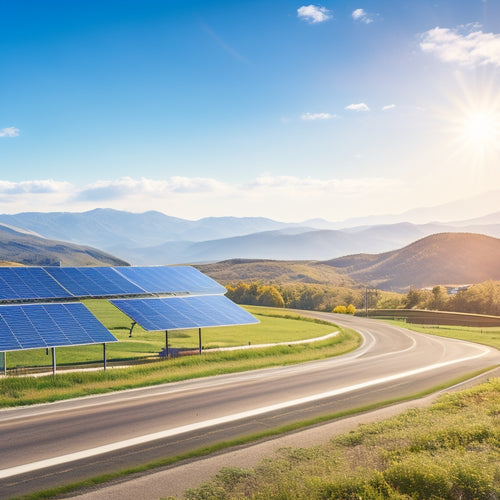
What's Involved in DIY Home Panel Installation
Share
When tackling a DIY home panel installation, you'll need to follow a thorough process. First, assess your energy needs by reviewing past utility bills and conducting an energy audit. Next, choose the right equipment, ensuring compatibility with your roof type and energy system. Prepare your roof structure by inspecting its condition, checking for obstructions, and obtaining necessary permits. Install the panels safely, following manufacturer guidelines and wearing personal protective equipment. Connect the panels to your home's electrical panel, ensuring compliance with local codes. Finally, monitor and maintain performance, regularly inspecting the system and addressing any issues that arise - and that's just the beginning of your DIY solar panel expedition.
Key Takeaways
- Assess energy needs by reviewing utility bills and conducting an energy audit to determine ideal solar panel system size.
- Choose compatible equipment, including high-efficiency panels, suitable mounting systems, and necessary tools and accessories.
- Prepare the roof structure by inspecting for damage, ensuring structural integrity, and repairing or replacing roofing materials as needed.
- Install solar panels safely by following manufacturer instructions, wearing personal protective equipment, and maintaining clear communication among team members.
- Connect the solar panel system to the home's electrical panel, ensuring compliance with local building codes and electrical standards.
Assessing Your Energy Needs
As you prepare to install solar panels on your home, alongside considering the system's size and cost, evaluating your energy needs is an essential step in determining how much energy you need to generate.
To do this, you'll need to assess your energy consumption patterns. Review your past utility bills to understand your average daily energy usage in kilowatt-hours (kWh). This will help you determine the ideal system size for your home.
Conducting an energy audit energy-intensive appliances can also help you identify areas of high energy usage and opportunities for improvement.
Additionally, researching available solar incentives in your area can help you maximize your savings.
Choosing the Right Equipment
You'll need to verify that the solar panels you've selected are compatible with your mounting system, inverter, and other equipment, guaranteeing a seamless integration.
It's crucial to take into account high-efficiency panels and durable mounting systems to confirm a successful installation. Additionally, keep in mind the structural soundness of your roof and regular maintenance requirements.
Next, you'll want to gather the necessary tools and accessories, such as wire cutters, connectors, and a multimeter, to complete the installation efficiently.
Panel Compatibility Check
Beyond the excitement of selecting your DIY home panel, lies an essential step: confirming compatibility.
You'll need to verify that your chosen panel type aligns with your home's specific requirements. This includes checking the panel's compatibility with your existing electrical system, roof type, and local building codes.
Some key factors to take into account:
- Verify the panel's voltage and amperage ratings match your home's electrical system
- Confirm the panel's mounting system is compatible with your roof type (e.g., asphalt shingle, metal, or tile)
- Check local building codes and regulations for specific installation guidelines
- Ensure the panel's warranty and certifications (e.g., UL, IEEE) meet your needs
Tools and Accessories Needed
With your DIY home panel selected and compatibility confirmed, it's time to gather the necessary tools and accessories to secure a successful installation. You'll need a combination of safety gear, electrical testing equipment, and installation-specific tools to guarantee a smooth process.
| Tool/Accessory | Description |
| Voltage tester | Verify electrical safety before installation |
| Wire strippers | Prepare wires for connection to the panel |
| Safety gloves | Protect yourself from electrical shock and cuts |
| Panel-specific mounting hardware | Secure the panel to your wall or roof |
Remember to follow proper safety precautions and installation techniques to avoid any potential risks or damage to your system.
Preparing Your Roof Structure
You'll need to assess your roof's condition before installing home panels.
Start by creating a roof inspection checklist to identify potential issues, such as damaged, missing, or loose shingles, and signs of wear around chimneys, vents, and skylights.
Consider factors like solar panel orientation and ideal site selection to guarantee maximum energy production.
Next, perform a structural integrity check to verify your roof can support the weight of the panels and withstand environmental stresses.
Roof Inspection Checklist
Get your roof structure ready for the solar panel installation by ticking off each item on this essential checklist.
You'll want to guarantee your roof is free from damage and ready for the added weight of the panels. Start by inspecting your roof for signs of wear, such as curled or missing shingles, and repair or replace them as needed. This will prevent any further roof damage during the installation process.
- Verify that your roof is structurally sound and can support the weight of the solar panels
- Check for any obstructions, such as skylights or vents, that may interfere with the installation
- Obtain all necessary installation permits from your local government
- Ascertain your roof is clean and clear of debris to facilitate a smooth installation
Structural Integrity Check
Guaranteeing your roof's structural integrity is paramount before installing solar panels, as it will bear the weight of the added components.
You'll need to perform load calculations to determine the maximum weight your roof can support. This involves evaluating the roof's current load, including the weight of the roofing material, rafters, and trusses.
Additionally, you'll need to assess the foundation stability, guaranteeing it can handle the increased weight and stress of the solar panels.
A thorough structural integrity check will identify any weaknesses or vulnerabilities, allowing you to address them before installation.
This critical step will ensure a safe and secure installation, preventing potential damage to your roof or injury to people and property.
Installing Solar Panels Safely
When tackling a DIY solar panel installation, safety should be top of mind from the outset, particularly when working at heights or with electrical systems. You must take necessary safety precautions to avoid injuries and guarantee a successful installation.
-
Wear personal protective equipment (PPE) like hard hats, gloves, and safety glasses to prevent physical harm.
-
Follow installation guidelines and manufacturer instructions to avoid electrical shocks and fires.
-
Confirm a stable and secure ladder or scaffolding system to prevent falls.
- Turn off the main power supply to the installation area to prevent accidental energization.
Connecting to Your Home
Connecting your solar panel system to your home's electrical infrastructure is a critical step in the DIY installation process.
You'll need to connect the solar panels to your home's main electrical panel, guaranteeing a safe and efficient grid connection. This requires careful planning and attention to detail to avoid electrical shock or fire hazards.
You'll need to determine the correct wiring configuration, disconnect switches, and circuit breakers to facilitate energy efficiency. Proper connection will enable your solar panel system to feed excess energy back into the grid, reducing your energy bills.
Verify you comply with local building codes and electrical standards to assure a safe and effective connection.
Monitoring and Maintaining Performance
Now that your solar panel system is connected to your home's electrical infrastructure, it's time to focus on monitoring and maintaining its performance. This is vital to guarantee your system operates at its best level and provides the expected energy efficiency.
You'll need to track your system's performance regularly, identifying any issues that may arise and addressing them promptly.
- Regularly inspect your system to detect any signs of performance degradation
- Clean your panels periodically to guarantee maximum energy absorption
- Monitor your inverter's performance and troubleshoot any issues that arise
- Consider weather conditions that may affect your system's performance and plan accordingly
Frequently Asked Questions
Can I Install Solar Panels on a Metal or Clay Tile Roof?
You're venturing into uncharted territory, like Odysseus traversing the Strait of Messina, when considering solar panel installation on metal or clay tile roofs. Be prepared to tackle unique challenges, such as specialized mounting systems and waterproofing, specific to these roof types.
Will DIY Solar Panels Affect My Home's Resale Value?
You'll be relieved to know that DIY solar panels can actually enhance your home's resale value, thanks to solar panel incentives, which are factored into a thorough home value assessment, elevating your property's appeal to potential buyers.
Are There Any Local Building Codes or Permits Required?
As you envision your solar panel system, imagine traversing a maze of red tape - you'll need to secure local permits and comply with building regulations, ensuring your installation meets strict standards, avoiding costly rework and potential fines.
Can I Mix Old and New Solar Panels in My Installation?
You'll need to guarantee panel compatibility when mixing old and new solar panels, as differing efficiencies and voltage ratings can impact your installation's overall performance and efficiency, potentially reducing its power output and longevity.
Will Solar Panels Work During a Power Outage?
Imagine a stormy night, and you're the captain of your own energy ship. Unfortunately, your solar panels won't be your guiding light during a power outage, as they're grid-tied for safety and efficiency; however, you can investigate power outage solutions like battery backup systems to stay lit.
Related Posts
-

Is Switching to Green Energy Solutions Easy
Switching to green energy solutions isn't just easy; it's also beneficial. You can greatly cut utility costs and enjo...
-

Top Portable Refrigerators for Camping Adventures
When you're camping, having a reliable portable refrigerator can make all the difference for keeping your food fresh ...
-

Cost of Solar Panel Installation
You can expect to pay between $15,000 and $30,000 or more for a typical solar panel installation, depending on the sy...


